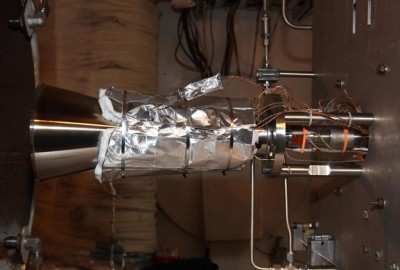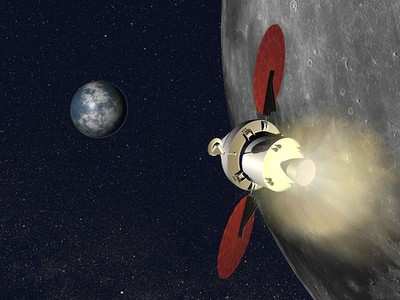Mon, Nov 28, 2011
Design Verification Testing Completed On First MR-104G Engine
For NASA's Orion Spacecraft
Aerojet said Tuesday it has successfully completed vibration,
shock and hot fire design verification testing on its first MR-104G
monopropellant rocket engine planned for use on NASA's Orion
spacecraft. The testing was done in conjunction with Lockheed
Martin and NASA. Twelve 160-lbf thrust MR-104G engines, arranged in
four single-engine pods and four dual-engine pods, provide the full
complement of primary and redundant control required for critical
maneuvers upon a high-speed re-entry into Earth's atmosphere.
MR-104G Engine

The first phase of the MR-104G design verification testing was a
critical milestone in the development of the Orion Crew Module
propulsion system and marks a significant step toward Orion's first
orbital flight test. Orion-specific environment, performance and
life requirements were demonstrated as part of this test program in
support of the flight test plan. The design verification testing
program consisted of vibration and shock testing to appropriately
stress the engine structure and catalyst bed similar to launch
environments prior to engine hot fire testing. The hot fire test
then demonstrated the engine performance and life capability, along
with thermal model validations with cold starts, hot restarts and
deep thermal cycles.
Several new design features for the MR-104G engine were
demonstrated in this testing series, including a newly developed
120-volt series-redundant propellant valve, a 120-volt/40 watt
catalyst bed heater, a new chamber pressure transducer and an
integral thruster mount configuration.
NASA Image

The MR-104 engine family originally provided in-space propulsion
for the Voyager 1 and 2 and Magellan missions. Subsequent MR-104
variants provided propulsion for Landsat, NOAA as well as other
U.S. government programs.
"Aerojet is very proud of its support of the crew module's
liquid propulsion systems for the Orion spacecraft," said Sam
Wiley, Aerojet's Orion program director. "We are excited to provide
spacecraft propulsion engines to be used for the next generation of
human spaceflight and continue our track record of 100 percent
mission success for NASA's human spaceflight dating back to
Apollo."
More News
Light Gun A handheld directional light signaling device which emits a brilliant narrow beam of white, green, or red light as selected by the tower controller. The color and type of>[...]
"The journey to this achievement started nearly a decade ago when a freshly commissioned Gentry, driven by a fascination with new technologies and a desire to contribute significan>[...]
Aero Linx: JAARS, Inc. For decades now, we’ve landed planes on narrow rivers and towering mountains. We’ve outfitted boats and vehicles to reach villages that rarely se>[...]
"Our driven and innovative team of military and civilian Airmen delivers combat power daily, ensuring our nation is ready today and tomorrow." Source: General Duke Richardson, AFMC>[...]
Aircraft Conflict Predicted conflict, within EDST of two aircraft, or between aircraft and airspace. A Red alert is used for conflicts when the predicted minimum separation is 5 na>[...]
 ANN's Daily Aero-Term (04.20.24): Light Gun
ANN's Daily Aero-Term (04.20.24): Light Gun Aero-News: Quote of the Day (04.20.24)
Aero-News: Quote of the Day (04.20.24) ANN's Daily Aero-Linx (04.21.24)
ANN's Daily Aero-Linx (04.21.24) Aero-News: Quote of the Day (04.21.24)
Aero-News: Quote of the Day (04.21.24) ANN's Daily Aero-Term (04.21.24): Aircraft Conflict
ANN's Daily Aero-Term (04.21.24): Aircraft Conflict




